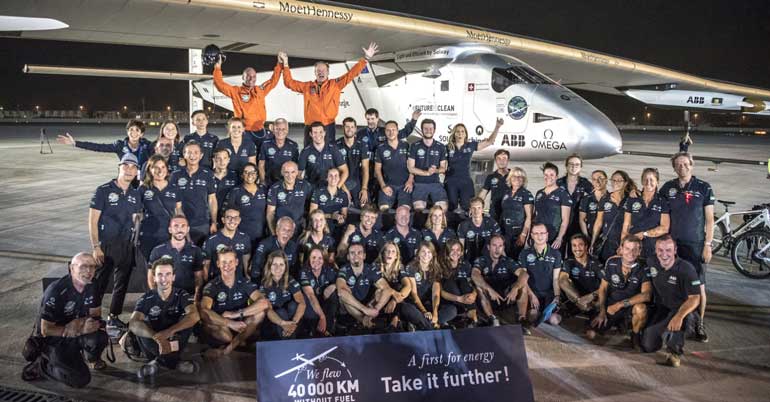Sunday Mar 16, 2025
Sunday Mar 16, 2025
Monday, 1 August 2016 00:00 - - {{hitsCtrl.values.hits}}

Solar Impulse 2, the solar powered plane, piloted by Swiss pioneer Bertrand Piccard, is seen before landing in Abu Dhabi to finish the first around the world flight without the use of fuel, United Arab Emirates last week - SI2/Handout via Reuters

Swiss pioneers Bertrand Piccard (top L) and Andre Borschberg (top R) celebrate with the Solar Impulse team after landing in Abu Dhabi, United Arab Emirates - Jean Revillard, Bertrand Piccard/SI2/Handout via Reuters
Abu Dhabi (Reuters): A solar-powered aircraft successfully completed the first fuel-free flight around the world last week, returning to Abu Dhabi after an epic 16-month voyage that demonstrated the potential of renewable energy.
It first took off from Abu Dhabi on March 9, 2015, beginning a journey of about 40,000 km (24,500 miles) and nearly 500 hours of flying time.
Bertrand Piccard and Andre Borschberg, the Swiss founders of the project, took turns piloting the aircraft, which has a wingspan larger than a Boeing 747 but weighs no more than an average family car.
“More than an achievement in the history of aviation, Solar Impulse has made history in energy,” Piccard, who piloted the plane on the last leg, told a large crowd on landing.
“I’m sure that within the next 10 years we’ll see electric airplanes carrying 50 passengers on short- to medium-haul flights,” he said in a statement.
He said the technologies used on Solar Impulse 2 could be used on the ground in daily life to halve emissions of carbon dioxide, the main greenhouse gas blamed for climate change.
The propeller-driven aircraft’s four engines are powered by energy collected from more than 17,000 solar cells built in the wings. Excess energy is stored in batteries.
Unfavorable weather at times hindered smooth flying, causing the plane to be grounded for months in some countries. In all, the plane had 16 stopovers. The pilots also had to demonstrate the mental stamina required to tackle vast distances alone at a cruising speed of no more than 90 km (56 miles) per hour and altitudes of up to 9,000 meters (29,500 feet).
“We were facing the oceans... We had to build up this mindset, not just the plane and technology,” Piccard told reporters.
For the two pilots, landing back where they started is only “the beginning of the continuation” of a longer journey, said Piccard, who in 1999 became the first person to circumnavigate the globe non-stop in a hot air balloon.
Aside from continuing to promote renewable energy, they plan to launch an international council to advise governments and develop new applications for clean energy technology.
Discover Kapruka, the leading online shopping platform in Sri Lanka, where you can conveniently send Gifts and Flowers to your loved ones for any event including Valentine ’s Day. Explore a wide range of popular Shopping Categories on Kapruka, including Toys, Groceries, Electronics, Birthday Cakes, Fruits, Chocolates, Flower Bouquets, Clothing, Watches, Lingerie, Gift Sets and Jewellery. Also if you’re interested in selling with Kapruka, Partner Central by Kapruka is the best solution to start with. Moreover, through Kapruka Global Shop, you can also enjoy the convenience of purchasing products from renowned platforms like Amazon and eBay and have them delivered to Sri Lanka.
Discover Kapruka, the leading online shopping platform in Sri Lanka, where you can conveniently send Gifts and Flowers to your loved ones for any event including Valentine ’s Day. Explore a wide range of popular Shopping Categories on Kapruka, including Toys, Groceries, Electronics, Birthday Cakes, Fruits, Chocolates, Flower Bouquets, Clothing, Watches, Lingerie, Gift Sets and Jewellery. Also if you’re interested in selling with Kapruka, Partner Central by Kapruka is the best solution to start with. Moreover, through Kapruka Global Shop, you can also enjoy the convenience of purchasing products from renowned platforms like Amazon and eBay and have them delivered to Sri Lanka.